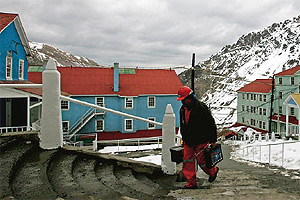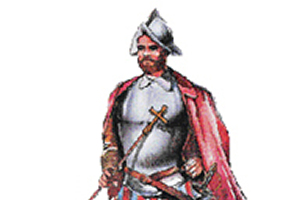According to the National Monuments Council, to this date there are 39 zones decreed in this category. They are land or marine areas that have a unique value from a geological, paleontological, zoological, botanical or ecological point of view. Their care and preservation are vital for the next generation to be able to enjoy their unmatched characteristics.
The sites that have been declared sanctuaries are left under the care of the National Monuments Council, and their upkeep is left to privates when its private property.
A few of the most well-known are:
– Valle de la Luna, de la Sierra de orbate (Valley of the Moon, of the orbate Sierra): it is part of the Los Flamencos National Reserve and corresponds to a land depression, which, after successive geological processes, acquired a particular appearance. It is made up by numerous salt and gypsum rocks that are highly eroded.
– Quinta Normal Park: located in the heart of one of Santiago’s comunas (counties), it is another one of the few sanctuaries located in an urban area. It value lies in sharing a balanced day to day life with nature; it has ancient trees and constructions within it, like the Natural History Museum.
– Pumalin Park: located in the region of los Lagos, it is one of the largest private parks in the world. It is characterized by its virgin environments, highly interesting for science and for recreation.
– The marble chapel: this sanctuary is found in General Carrera lake. Its main characteristics are the marble formations that have been created due to constant water erosion. It is possible to find numerous caves or grottos in different tones according to the purity of the marble and the presence of other minerals.
Archeological monuments
They correspond to places, deposits, ruins and anthropological archeological objects and paleontological objects that exist over or under the surface of our national territory. According to the law, they are property of the State, and one needs the authorization of the National Monuments Council to manipulate them. To this date there are 21 sites with this denomination. A few of them are:
– Tulor village: ruins that belong to a southern Andes settlement, near San Pedro de Atacama, that existed between the years 345 b.C. and 150 a.C. Evidence indicates that it could have been a farming and cattle breeding group that took advantage of the river swells to survive the zone’s arid climate.
– Incan fortress of Chena hill and its surroundings: located at the border of the comunas (counties) of San Bernardo and Calera de Tango, it corresponds to a pre-Hispanic Incan construction made out of rocks from the same hill it is located at. It is believed that it was used as a fortress and barracks for the Incan troops.
– Monte Verde Site: northeast of Puerto Montt, evidence was found of the existence of a Paleo-Indian settlement that belonged to a group of hunter-gatherers who might have been the continent’s first inhabitants.
The site, which consists of nearly 3,000 m2, not only houses some constructions, weapons and tools used by this ancient group, the remains of animals that were part of heir diet have also have also been found there.
Historical monuments
It is the most encompassing category of monuments. It refers to furnishings or real estate, which may be places, ruins, constructions or objects.
Until the beginning of this year, 633 furnishings were accounted for that had this denomination. Among the most well known, we can mention:
– Morro de Arica (Arica hill): this emblematic place, an icon of the Chilean victory against Peruvian troops during the first stage of the Pacific war, was appointed a historical monument in 1971. Today, it is one of the city’s most characteristic landmarks.
– Remains of corvette Esmeralda: the remains of the Esmeralda are submerged off the bay of Iquique. This vessel participated in the naval battle of Iquique on May 21st, 1879. A buoy indicated the exact spot where the remains are located and the Chilean Navy is in charge of preserving them. They were declared a historical monument in 1973.
– 16 Pullman brand trolleys: as of 1953, trolleys began to be used in the city of Valparaiso. To this day, they travel a little over eight kilometers, from Argentina avenue to the old Customs house. It is oldest means of transportation of its kind that is still operational in the world. They were named historical monuments in 2003.
– Wulff Castle: in the rockery that is between the mouth of the Marga-Marga and Abarca cove one may find one of Viña del Mar’s most typical constructions. It was built as a residence for Gustavo Adolfo Wulff and presently the castle houses the Unidad de Patrimonio de la Municipalidad de Viña del Mar (Heritage Unit of the Municipality of Viña del Mar). It is one of the most representative spaces of this tourist drawing city.
– Villa Grimaldi Park for Peace: located in the comuna (county) of Peñalolen, this place was declared a national monument in order to preserve the country’s recent memory. The site, which consists of a few characteristic sectors like the Torre (Tower) or the Corvi Houses, is the only detention and torture center in Latin America that has managed to be recovered and preserved to promote human rights.
Typical zones
In order for an area to be deemed a typical zone it must correspond to urban or rural complexes and the surroundings of some historical monuments. They have to have architectural, historical or environmental value. A few that we can mention are:
– The town of Isluga: this small village is located in the comuna (county) of Colchane, in the region of Tarapaca. It has no more than 100 homes. Its typical architecture and the presence of a church that date back to the XVIII century, which as a bell tower, make it a unique location located in our country’s high plateau.
– Cartagena’s coastal border: this sector is a silent witness of what the beach town was at the ends of the XIX century and early XX century, during the belle époque. Santiago’s Aristocratic families skimped on no expense to recreate European luxury in this place, even including prefab houses from Paris.
– Sewell: in 1998, the National Monuments Council named Sewell mining camp a typical zone due to its historical and heritage value. It is located in the Andes mountains in the region of Libertador Bernardo O’Higgins.
The area, outfitted to receive miners and their families from El Teniente mine since the beginning of the XX century, has unique architecture, specially designed for the place it is located, in the middle of the Andes mountains. Its historical importance led Unesco to catalogue it as a World Heritage Site in 2006.
– Mansions on Republica Avenue: in the college district of Republica avenue, between Sazie and Gay streets in the comuna (county) of Santiago, it is possible to find numerous mansions that date back to the end of the XIX century and the fist decades of the XX. They all represent a great economic boom that took place in the country and make up one of the most lavish parts of Santiago from the early 1900. Its urbanization called for paving of roads and public lighting for the streets.
– Tortel cove: this place has been considered a Typical Zone since May, 2001. Apart from its natural attractions, it also has a unique system of walkways and stairs created by the first people that inhabited the place and which today enable foot traffic amidst the harmony of nature. Housing constructions also respect the environment.
Monuments of Chile, keeping the memory alive
National monuments belong to all Chileans and they are things or places that have irreplaceable value, be it as historical evidence, natural value or aesthetic beauty. Many of them are unique traces of our history and their preservation is vital for new generations for they attempt to preserve the memory of our people.
According to Law 17,288, National Monuments are «places, ruins, constructions or objects that have historical or artistic traits; burial grounds or cemeteries or other aboriginal remains, anthropological-archeological, paleontology related or naturally formed pieces or objects that exist over or under the surface of our national territory or under jurisdictional waters and the conservation of which is in the best interest of history, art or science; nature sanctuaries; monuments, statues, columns, pyramids, fountains, plaques, crowns, inscriptions and, in general, all objects that are aimed at remaining in a public place with a commemorative spirit».
The National Monuments Council is the state body in charge of overseeing the classification, preservation and promotion of these objects and places. Each of them belongs in one of the five possible classification categories: historical monuments, typical zones, nature sanctuaries, archeological monuments and public monuments.
In order to catalogue a National Monument, there are two ways, depending on the category of the object or place. If we are talking about historical monuments, typical zones and nature sanctuaries, their appointment is done through a decree issued by the Ministry of Education; meanwhile, archeological monuments and public monuments are appointed by law.








